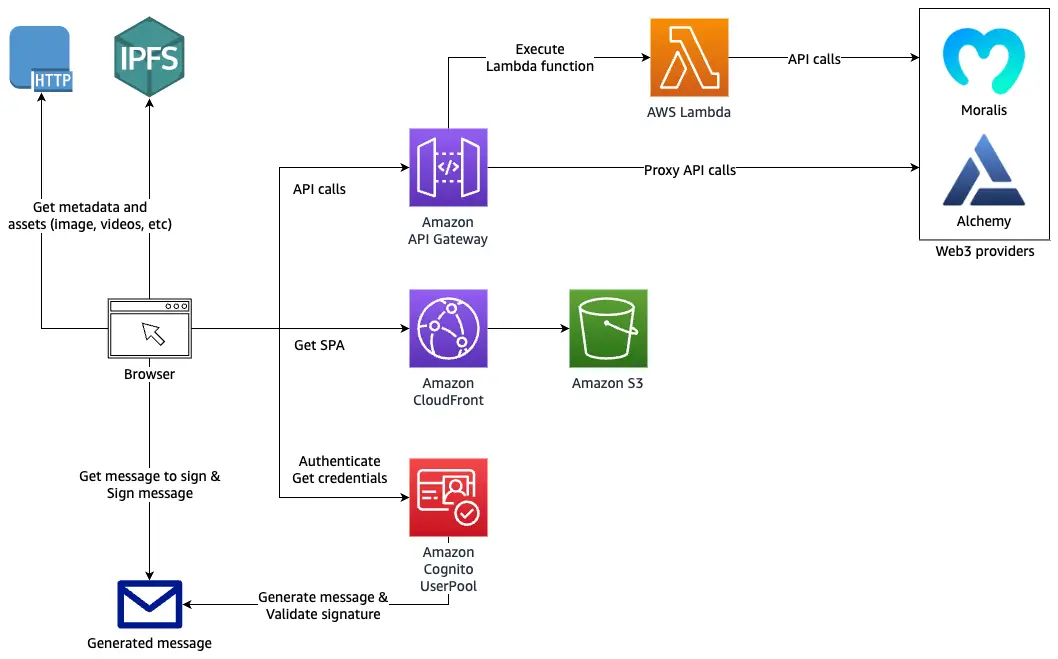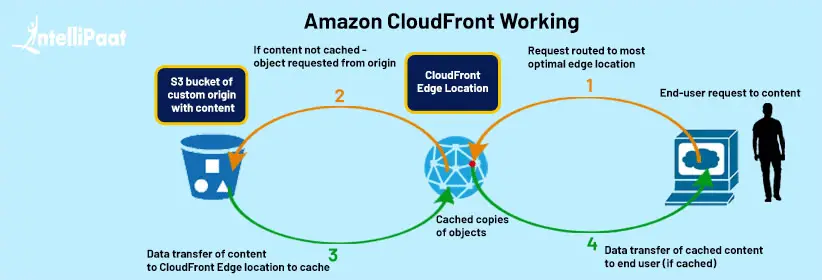Improved Performance and Scalability

- Amazon CloudFront reduces latency by caching content closer to end users, improving load times and responsiveness for web applications.
- It automatically scales capacity based on demand, ensuring high availability and performance during peak traffic periods.
Enhanced Security

- CloudFront uses SSL/TLS encryption to protect data in transit, preventing eavesdropping and man-in-the-middle attacks.
- It supports security features such as IP filtering and DDoS mitigation to protect AWS services from malicious traffic.
Simplified Service Integration

- CloudFront provides a unified interface for integrating with multiple AWS services.
- It supports seamless integration with services such as S3, EC2, and Lambda, enabling developers to easily deliver content and achieve end-to-end service visibility.
Cost Optimization
- CloudFront can help optimize costs by caching content that is frequently accessed, reducing the load on other AWS services.
- It uses multiple delivery methods, including traditional HTTP/HTTPS and QUIC, to minimize data transfer costs.
Specific Integration Benefits for AWS Services:
- S3: CloudFront can accelerate S3 content delivery by providing edge caching and fast transfer protocols.
- EC2: CloudFront can offload traffic from EC2 instances by caching static content, reducing instance load and improving overall application performance.
- Lambda: CloudFront can serve Lambda functions as static content, eliminating the need for frequent function invocations and reducing costs.
- API Gateway: CloudFront can act as a reverse proxy for API Gateway, caching responses and improving API latency and reliability.
- DynamoDB: CloudFront can cache read-heavy DynamoDB queries, reducing the number of direct database calls and improving application response times.
Additional Benefits:
- Global Availability: CloudFront has edge locations in over 200 countries, providing low-latency content delivery worldwide.
- Easy Management: CloudFront can be managed through the AWS console or programmatically via the API, making it easy to configure and manage.
- Analytics and Monitoring: CloudFront provides detailed analytics and monitoring tools to track performance and usage patterns, enabling continuous optimization.## The Impact Of Amazon Cloudfront On AWS Service Integration
Executive Summary
Amazon Cloudfront is a content delivery network (CDN) that helps deliver content to users with low latency and high throughput. It is a global network of edge locations that cache content and deliver it to users from the nearest location. Cloudfront can be used to deliver a variety of content, including static and dynamic web pages, videos, images, and software downloads.
Cloudfront is tightly integrated with other AWS services, such as Amazon S3, Amazon EC2, and Amazon Lambda. This integration makes it easy to use Cloudfront to deliver content from these services. For example, you can use Cloudfront to deliver static content from Amazon S3, or you can use it to deliver dynamic content from an Amazon EC2 instance.
The integration between Cloudfront and other AWS services provides a number of benefits. These benefits include:
- Reduced latency: Cloudfront’s edge locations are located around the world, which reduces the latency of content delivery.
- Increased throughput: Cloudfront’s edge locations can handle a large amount of traffic, which increases the throughput of content delivery.
- Improved reliability: Cloudfront’s edge locations are redundant, which improves the reliability of content delivery.
- Reduced costs: Cloudfront can help reduce costs by reducing the amount of bandwidth that is used to deliver content.
Introduction
Amazon Cloudfront is a content delivery network (CDN) that helps deliver content to users with low latency and high throughput. It is a global network of edge locations that cache content and deliver it to users from the nearest location. Cloudfront can be used to deliver a variety of content, including static and dynamic web pages, videos, images, and software downloads.
Cloudfront is tightly integrated with other AWS services, such as Amazon S3, Amazon EC2, and Amazon Lambda. This integration makes it easy to use Cloudfront to deliver content from these services. For example, you can use Cloudfront to deliver static content from Amazon S3, or you can use it to deliver dynamic content from an Amazon EC2 instance.
FAQs
What is Amazon Cloudfront?
Amazon Cloudfront is a content delivery network (CDN) that helps deliver content to users with low latency and high throughput. It is a global network of edge locations that cache content and deliver it to users from the nearest location. Cloudfront can be used to deliver a variety of content, including static and dynamic web pages, videos, images, and software downloads.
How does Amazon Cloudfront work?
Cloudfront works by caching content on its edge locations. When a user requests content from a website that is using Cloudfront, the request is routed to the nearest edge location. If the content is cached on the edge location, it is delivered to the user from that location. If the content is not cached on the edge location, it is fetched from the origin server and then cached on the edge location.
What are the benefits of using Amazon Cloudfront?
There are a number of benefits to using Amazon Cloudfront, including:
- Reduced latency: Cloudfront’s edge locations are located around the world, which reduces the latency of content delivery.
- Increased throughput: Cloudfront’s edge locations can handle a large amount of traffic, which increases the throughput of content delivery.
- Improved reliability: Cloudfront’s edge locations are redundant, which improves the reliability of content delivery.
- Reduced costs: Cloudfront can help reduce costs by reducing the amount of bandwidth that is used to deliver content.
Subtopics
Content Delivery
Cloudfront delivers content to users from the nearest edge location, which reduces latency and improves performance.
- Edge locations: Cloudfront has a global network of edge locations that are located in close proximity to users.
- Caching: Cloudfront caches content on its edge locations, which reduces the amount of time it takes to deliver content to users.
- Dynamic content: Cloudfront can also deliver dynamic content, such as web pages that are generated on the fly.
Security
Cloudfront provides a number of security features to protect content, including:
- SSL/TLS: Cloudfront supports SSL/TLS encryption to protect data in transit.
- Access control: Cloudfront can be used to restrict access to content based on IP address, geographic location, or other criteria.
- Origin protection: Cloudfront can be used to protect origin servers from DDoS attacks and other threats.
Integration
Cloudfront is tightly integrated with other AWS services, which makes it easy to use Cloudfront to deliver content from these services.
- Amazon S3: Cloudfront can be used to deliver static content from Amazon S3.
- Amazon EC2: Cloudfront can be used to deliver dynamic content from Amazon EC2 instances.
- Amazon Lambda: Cloudfront can be used to deliver content from Amazon Lambda functions.
Performance
Cloudfront is designed to deliver content with high performance, including:
- Low latency: Cloudfront’s edge locations are located around the world, which reduces the latency of content delivery.
- High throughput: Cloudfront’s edge locations can handle a large amount of traffic, which increases the throughput of content delivery.
- Scalability: Cloudfront can be scaled to meet the needs of any website or application.
Cost
Cloudfront is a cost-effective way to deliver content, including:
- Pay-as-you-go pricing: Cloudfront is priced on a pay-as-you-go basis, which means that you only pay for the resources that you use.
- Volume discounts: Cloudfront offers volume discounts for customers who use a large amount of bandwidth.
- Free tier: Cloudfront offers a free tier that includes 50GB of data transfer per month.
Conclusion
Amazon Cloudfront is a powerful content delivery network (CDN) that can help you deliver content to users with low latency and high throughput. Cloudfront is tightly integrated with other AWS services, which makes it easy to use Cloudfront to deliver content from these services. Cloudfront is also designed to be secure, performant, and cost-effective.
Keyword Tags
- Amazon Cloudfront
- Content delivery network (CDN)
- Low latency
- High throughput
- AWS integration
